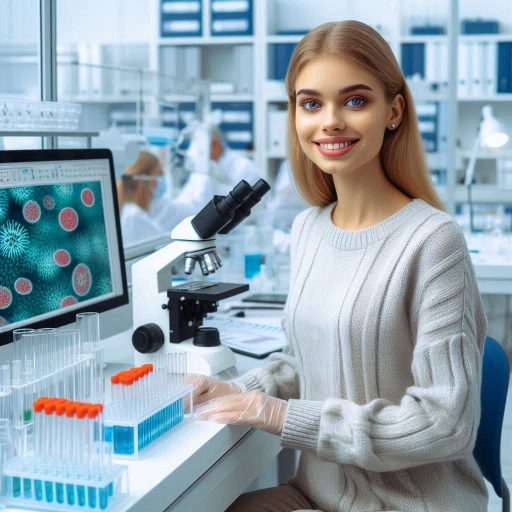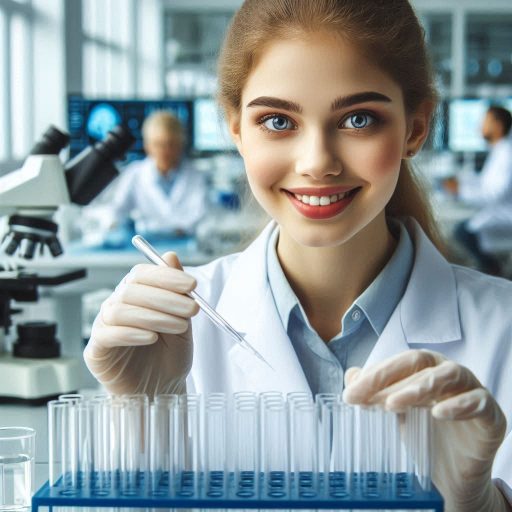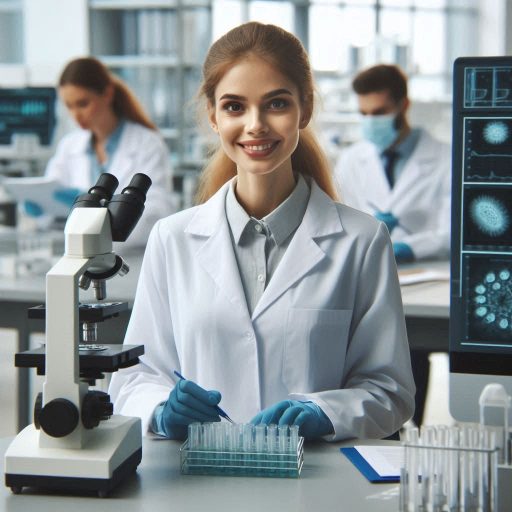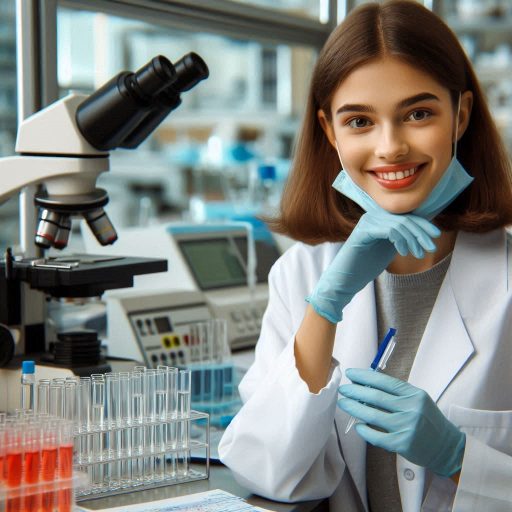Introduction
A microbiologist studies microorganisms, including bacteria, viruses, fungi, and protozoa, to understand their behavior, growth, and interactions.
Their work is critical to multiple industries, including healthcare, agriculture, food production, and environmental science.
In healthcare, microbiologists help identify pathogens and develop treatments for infections and diseases.
In agriculture, they contribute to soil health and crop production by studying microbes that affect plant growth.
The food industry relies on microbiologists to ensure food safety through microbial testing and contamination prevention.
Environmental microbiologists analyze the role of microbes in ecosystems, focusing on pollution control, waste management, and resource sustainability.
There are different types of microbiologists, each specializing in distinct areas.
Clinical microbiologists work in laboratories, diagnosing diseases and conducting research on infectious agents.
Industrial microbiologists focus on creating products like antibiotics, enzymes, and biofuels by harnessing microbial processes.
Environmental microbiologists study microorganisms in soil, water, and air, aiming to solve environmental challenges.
Food microbiologists focus on detecting and controlling harmful microbes in food products to maintain safety standards.
Lastly, research microbiologists focus on fundamental questions about microbial biology, often leading to discoveries that impact various industries.
In all these fields, microbiologists play an essential role in solving global challenges, from public health to environmental sustainability, making their work crucial for improving quality of life.
Morning Routine
A typical morning routine for a microbiologist
A microbiologist’s day usually begins early, around sunrise, as their work requires long hours of focus.
The first task is organizing the lab space to ensure cleanliness and safety, a critical step in avoiding contamination.
Next, they review the schedule for the day, prioritizing tasks based on urgency and the time required for each experiment.
This organized approach keeps the day on track.
After setting up, the microbiologist prepares any tools, equipment, and reagents needed for experiments.
Sterilizing tools, laying out protective gear, and ensuring everything is in place are part of the morning routine.
By doing so, they minimize delays later in the day, allowing them to focus entirely on the experiments.
The Importance of Starting the Day Early to Accommodate Experiments
Starting early is crucial for microbiologists due to the time-sensitive nature of their work.
Many experiments require several hours, or even days, to complete.
By beginning early, they maximize the amount of time available to monitor and adjust experiments throughout the day.
Some tests, such as microbial growth monitoring, need to be checked at regular intervals.
An early start ensures the microbiologist can follow up at the right moments, preventing delays that could impact the results.
Moreover, the quiet of the early hours provides a distraction-free environment.
This time is often used to handle delicate processes like sample preparation, ensuring precision and reducing the risk of error.
The Preparation of Samples for Analysis
Once the workspace is prepared, the microbiologist turns their attention to sample preparation.
This is a crucial step in the process, as it lays the foundation for all experiments.
Samples are often bacteria, fungi, or other microorganisms, and must be handled with extreme care.
The microbiologist follows strict sterile procedures, including wearing gloves, masks, and lab coats, to prevent contamination.
Sample preparation may involve diluting specimens, creating cultures, or inoculating petri dishes.
These samples are then transferred to incubators or controlled environments where they can grow.
During this stage, the microbiologist sets precise conditions, such as temperature and humidity, to match the needs of the organisms being studied.
Any deviation from the required parameters could skew the results, so accuracy is critical.
By ensuring that all samples are correctly prepared in the morning, the microbiologist can focus on monitoring and adjusting experiments throughout the rest of the day.
This careful preparation also allows the microbiologist to begin data collection as soon as conditions are met, leading to more efficient and accurate results.
Read: Challenges and Rewards: The Dual Life of an U.S. Environmental Scientist
Laboratory Work
The tasks involved in a microbiologist’s daily laboratory work
A microbiologist‘s daily laboratory work centers around conducting experiments, analyzing samples, and recording results.
One of the primary tasks is preparing specimens, which involves collecting, culturing, and isolating microorganisms for study.
These specimens could come from water, soil, food, or human and animal tissues.
Microbiologists use their expertise to examine the behavior, characteristics, and growth of microbes.
This analysis can help in diagnosing diseases, developing antibiotics, or improving industrial processes.
The use of various equipment and instruments for analysis
A key part of a microbiologist’s workday involves running tests and experiments to analyze the composition of microorganisms.
This requires using advanced instruments such as microscopes, autoclaves, incubators, and centrifuges.
Microscopes allow microbiologists to examine microorganisms at a cellular level, identifying structures and behaviors not visible to the naked eye.
Autoclaves sterilize lab equipment and media, ensuring no contamination interferes with experiments.
Incubators control temperature, humidity, and other conditions necessary for optimal microbial growth.
Centrifuges separate components of a sample based on density.
Microbiologists also use spectrophotometers to measure how much light passes through a sample, indicating the concentration of bacteria or other microorganisms.
Polymerase Chain Reaction (PCR) machines are essential for amplifying small samples of DNA, making them easier to study.
These tools are crucial for identifying and understanding the microorganisms present in various samples.
The precautions taken to ensure safety and accuracy in experiments
Every task in a microbiologist’s laboratory work requires a high degree of precision and care.
Safety is a top priority, as many microorganisms pose potential hazards.
To protect themselves and their work, microbiologists follow strict safety protocols.
This includes wearing personal protective equipment (PPE), such as gloves, lab coats, and goggles, to avoid exposure to harmful microbes.
Biological safety cabinets and fume hoods provide further protection by preventing harmful organisms from escaping into the open lab.
To ensure the accuracy of experiments, microbiologists take extra precautions to avoid contamination.
Sterile techniques are essential when handling samples, tools, and media.
This means using sterilized equipment and practicing aseptic methods to prevent introducing unwanted microorganisms into the experiment.
Failure to do so can compromise the integrity of the results and skew the data.
In addition to maintaining a clean workspace, microbiologists keep detailed records of their work.
This includes documenting procedures, observations, and any anomalies they encounter.
Accurate record-keeping ensures experiments can be replicated or adjusted if necessary.
It also helps track progress, providing a clear timeline of findings and developments.
Overall, a microbiologist‘s daily laboratory work is both complex and rewarding.
By carefully conducting experiments, using sophisticated equipment, and following strict safety protocols, they help advance our understanding of microorganisms and their impact on health, industry, and the environment.
Read: Job Market Trends: Future of Chemistry Jobs in America
Data Analysis in Microbiology
The process of analyzing data collected from experiments
Data analysis is a critical step in microbiology, transforming raw experimental data into meaningful conclusions.
Once microbiologists collect data from experiments, they begin by organizing it into manageable sets.
This often involves inputting data into statistical software or spreadsheets for easier examination.
During this phase, microbiologists ensure the accuracy and completeness of their data.
They may clean the dataset by removing outliers or correcting errors, preparing it for a detailed analysis.
After the data is prepared, microbiologists apply statistical tests to identify trends and patterns.
These tests help determine if the observed changes or results are statistically significant.
For instance, when studying bacterial growth under different conditions, microbiologists use statistical comparisons to assess whether variations in growth rates are due to experimental treatments or random chance.
Choosing the appropriate test is crucial, as it ensures the validity of the results.
How microbiologists interpret results to draw conclusions.
Microbiologists visualize their data through charts, graphs, and tables to aid in interpretation.
These visualizations make it easier to spot anomalies, trends, or correlations that might not be apparent in raw numbers.
For example, a microbiologist studying antibiotic resistance might use a bar chart to compare the effectiveness of different antibiotics on bacterial strains.
This visual aid helps clearly present the data and supports informed decision-making.
Interpreting results is the next key step.
Microbiologists critically evaluate the data in the context of their original hypothesis.
They ask questions such as:
Does the data support the hypothesis?
Are there unexpected outcomes that need further investigation?
Microbiologists look for patterns that explain the mechanisms behind their observations, such as why a specific treatment led to reduced bacterial growth.
This step requires a combination of scientific knowledge and analytical thinking.
The significance of data analysis in shaping research outcomes
Once they interpret the data, microbiologists draw conclusions that help answer their research questions.
These conclusions are not drawn in isolation; they are compared with existing scientific literature to identify similarities or differences with previous findings.
This comparison is essential because it situates the study within the broader context of microbiology research, allowing scientists to see where their work fits into the larger scientific conversation.
The significance of data analysis in microbiology cannot be overstated.
It shapes the entire direction of research by determining the validity of experimental results.
Proper analysis can lead to groundbreaking discoveries, while poor analysis risks misinterpretation and flawed conclusions.
In the long run, accurate data analysis helps microbiologists refine their experiments, improve protocols, and ultimately contribute to advancements in areas like medicine, environmental science, and biotechnology.
Through this rigorous process, data analysis turns raw information into valuable insights, guiding microbiologists in their quest for scientific discovery.
Read: Challenges and Rewards: Navigating the Chemist Career Path
Collaboration with Team Members
The Importance of Teamwork in Microbiology Research
Teamwork plays a critical role in microbiology research.
Microbiologists often collaborate with other scientists to pool their expertise and solve complex problems.
Working alone limits the scope of experiments, while collaboration opens doors to new perspectives and innovative solutions.
Each member of a research team brings a unique skill set, helping to address different facets of a study.
Whether developing new antibiotics or studying microbial ecology, success in microbiology often depends on collaborative efforts.
How Microbiologists Collaborate with Other Scientists and Researchers
Microbiologists frequently collaborate with researchers from various scientific disciplines, such as biochemists, molecular biologists, and bioinformaticians.
These collaborations allow for a more comprehensive approach to research projects.
For example, microbiologists studying bacterial resistance may work closely with chemists who understand the molecular structure of compounds.
Together, they can develop more effective strategies for combating antibiotic resistance.
Similarly, bioinformaticians can analyze large datasets generated by microbiologists, uncovering patterns that would be difficult to identify otherwise.
This interdisciplinary approach enhances the quality and accuracy of research outcomes.
The Benefits of Sharing Ideas and Resources within a Team Environment
Sharing ideas and resources is another key aspect of collaboration in microbiology.
Open communication within a research team promotes the exchange of knowledge, which can accelerate problem-solving and innovation.
Team members can contribute different hypotheses, propose alternative experimental methods, and provide critical feedback during project development.
This constant dialogue often leads to more thorough experimentation and robust conclusions.
Furthermore, sharing laboratory equipment, samples, and datasets ensures that all members have access to the resources they need, minimizing redundancy and maximizing productivity.
The benefits of collaboration extend beyond the immediate research project.
Building strong professional relationships within a team often leads to long-term partnerships.
These collaborations can result in co-authored publications, grant proposals, and future research opportunities.
By working together, microbiologists can enhance their reputation within the scientific community, gaining recognition for their contributions.
Additionally, learning from colleagues with different backgrounds can broaden a microbiologist‘s skill set, making them more adaptable and versatile in their careers.
Collaboration fosters a sense of camaraderie and mutual support among team members.
Research can be demanding, with challenges such as failed experiments or tight deadlines.
However, having a supportive team can alleviate stress and maintain motivation.
Sharing the workload helps balance responsibilities, allowing each member to focus on their strengths.
As a result, the team can achieve its goals more efficiently, ultimately advancing scientific knowledge in the field of microbiology.
In review, collaboration is essential to success in microbiology.
By working together, sharing ideas, and utilizing diverse skills, microbiologists can tackle complex challenges and contribute to scientific advancements more effectively than they could alone.
Read: Diverse Career Paths: From Chemist to Patent Attorney in the US

Fieldwork and Research
The Role of Fieldwork in a Microbiologist’s Job
Fieldwork is a crucial part of a microbiologist‘s job, allowing them to study microorganisms in their natural environments.
This hands-on approach provides critical insights that laboratory experiments alone cannot offer.
Microbiologists conduct fieldwork to collect samples from various ecosystems, including soil, water, plants, and animals.
These samples help them investigate microbial activity, interactions, and the effects of environmental conditions on microbial growth.
Fieldwork offers a more comprehensive understanding of microorganisms, laying the foundation for impactful research and discoveries.
The Process of Collecting Samples from Various Environments
The sample collection process is methodical and precise.
Microbiologists often begin by identifying key areas of interest, such as polluted water sources, agricultural fields, or remote natural habitats.
They carefully extract samples using sterile tools to prevent contamination and ensure the accuracy of their findings.
Depending on the research, microbiologists may collect air, soil, water, or biological specimens.
For instance, a microbiologist studying soil microbes will collect small soil samples at various depths, while those studying marine microorganisms might sample water at different ocean levels.
Each environment requires specialized equipment and techniques to capture the microorganisms effectively.
Once the samples are collected, they are transported back to the lab for analysis.
In the lab, microbiologists employ techniques like culturing and DNA sequencing to identify the microorganisms present and assess their functions.
The fieldwork provides real-world data, which is essential for understanding microbial diversity, ecological roles, and how microbes adapt to changing environments.
For example, researchers might discover new bacterial strains capable of breaking down pollutants or identify microbes crucial for nutrient cycling within ecosystems.
How Research Findings from Fieldwork Contribute to Scientific Knowledge
The research findings from fieldwork contribute significantly to scientific knowledge.
By studying microorganisms in their natural habitats, microbiologists uncover valuable information about biodiversity and microbial impacts on larger biological systems.
This research can lead to breakthroughs in medicine, agriculture, and environmental science.
For instance, fieldwork might reveal microbial communities that enhance crop growth or improve soil health.
Similarly, discovering new microorganisms in extreme environments, such as deep-sea vents or arid deserts, can provide insights into the potential for life in extraterrestrial conditions.
In addition to expanding scientific knowledge, the data collected during fieldwork informs public health policies and environmental protection efforts.
Microbiologists working in public health may track the spread of pathogens or assess the effectiveness of sanitation practices.
Meanwhile, environmental microbiologists might use their findings to advocate for more sustainable practices and improved ecosystem management.
Overall, fieldwork is integral to microbiology, shaping the future of scientific research and contributing to global challenges like climate change, disease control, and food security.
Transform Your Career Today
Unlock a personalized career strategy that drives real results. Get tailored advice and a roadmap designed just for you.
Start NowYou Might Also Like: Notable Climatologists and Their Contributions
Continuing Education and Professional Development
The Importance of Continuous Learning in the Field of Microbiology
Continuous learning is essential for microbiologists, given the fast-paced advancements in the field.
Staying current with research, tools, and methodologies can greatly enhance a microbiologist‘s effectiveness and career prospects.
The landscape of microbiology constantly evolves, from new diseases to innovative diagnostic techniques, so professionals must be proactive about expanding their knowledge.
Continuous education equips microbiologists with skills to address emerging challenges, ensuring their relevance in a competitive job market.
The Various Opportunities for Professional Development Available to Microbiologists
Numerous opportunities exist for microbiologists to continue their education.
One popular option is attending conferences and workshops.
These events offer chances to learn from experts, gain hands-on experience with new tools, and network with peers.
Conferences like the American Society for Microbiology (ASM) annual meeting provide valuable insights into emerging trends and technologies.
Workshops often focus on specialized skills, such as bioinformatics or pathogen detection, which can significantly enhance a microbiologist‘s technical expertise.
Another important avenue for professional development is obtaining certifications.
Certification programs, such as those offered by the National Registry of Certified Microbiologists (NRCM), demonstrate a professional’s competency in specific areas of microbiology.
Earning these credentials can lead to greater job opportunities and career advancement.
Certifications also encourage microbiologists to maintain high standards of practice and stay updated on the latest protocols.
Online courses and webinars provide additional learning opportunities, offering flexibility for busy professionals.
Many universities and organizations, like Coursera and ASM, offer microbiology courses on topics such as microbial genomics, environmental microbiology, and antimicrobial resistance.
Webinars allow microbiologists to learn from experts worldwide, staying informed about cutting-edge research from the comfort of their homes or labs.
The Importance of Staying Updated on the Latest Research and Technologies
Keeping up with scientific literature is another critical component of professional development.
Reading journals like Microbiology or Nature Reviews Microbiology ensures microbiologists are aware of recent discoveries and emerging research areas.
Subscribing to newsletters or joining professional organizations helps microbiologists stay informed about the latest trends and advancements in their field.
Regularly reviewing new studies can spark innovative ideas and inspire new research directions.
In a nutshell, continuous learning and professional development are vital for success in microbiology.
By staying informed about new research, technologies, and methodologies, microbiologists not only advance their careers but also contribute to the broader scientific community’s progress.
Embracing ongoing education prepares microbiologists for the challenges and opportunities of this dynamic, ever-evolving field.
Find Out More: Biomedical Engineering: Innovations in Rehabilitation
You Might Also Like: Nanotechnologist Salary: What to Expect
Challenges and Rewards
The Challenges Faced by Microbiologists in Their Daily Work
Microbiologists face numerous challenges in their daily work, which test their problem-solving and analytical skills.
A significant challenge is dealing with complex microorganisms that behave unpredictably under different conditions.
Every experiment requires meticulous planning and strict adherence to protocols, but unexpected results can still occur.
These deviations can lead to delays in research, forcing microbiologists to revisit and revise their methods.
The nature of biological organisms means that experiments can take weeks or even months, requiring patience and persistence.
Another challenge is the risk of contamination, which can compromise results.
Even with strict safety measures, working with microorganisms poses inherent risks to both the samples and the researcher.
One minor mistake in sterile technique can lead to contamination, rendering weeks of research useless.
This means that microbiologists must stay vigilant and maintain a high level of precision in every procedure they perform.
Time management is also a critical hurdle in microbiology.
Many microbiological processes take place over extended periods, requiring constant monitoring and adjustment.
Microbiologists often juggle multiple experiments simultaneously, making efficient time management crucial to success.
They must carefully coordinate each step to ensure everything runs smoothly while meeting tight deadlines.
How Overcoming Obstacles Can Lead to Personal and Professional Growth
Despite these challenges, overcoming obstacles in microbiology leads to both personal and professional growth.
Each failure teaches valuable lessons, encouraging microbiologists to refine their methods and improve their analytical thinking.
These experiences build resilience and foster a mindset of continuous learning.
The process of troubleshooting issues also sharpens problem-solving abilities, helping microbiologists adapt to the ever-changing demands of their research.
Persevering through setbacks often results in greater confidence and a sense of accomplishment.
When microbiologists successfully solve a problem or make a breakthrough, the satisfaction of overcoming adversity fuels further motivation.
These moments of success enhance their technical skills and contribute to their professional reputation, opening doors for future opportunities in the field.
The Rewards of Making Scientific Discoveries and Contributing to Advancements in the Field
The rewards of microbiology extend far beyond overcoming challenges.
The thrill of discovery drives many in the field.
Microbiologists have the opportunity to contribute to scientific advancements that have far-reaching impacts on health, agriculture, and the environment.
Whether it‘s identifying a new antibiotic or developing innovative methods for disease prevention, their work makes a tangible difference.
The knowledge that their efforts may lead to life-saving treatments or groundbreaking innovations provides immense satisfaction.
Each small discovery builds the foundation for future breakthroughs, making the long hours and hard work worthwhile.
In microbiology, the rewards of advancing scientific knowledge outweigh the difficulties, making the field both challenging and deeply fulfilling.
Conclusion
Microbiologists play a critical role in advancing our understanding of microscopic organisms that impact health, industry, and the environment.
Their daily responsibilities involve collecting samples, conducting experiments, and analyzing data to identify microorganisms.
They work across various sectors, such as healthcare, pharmaceuticals, agriculture, and environmental science, contributing valuable insights into disease prevention, food safety, and sustainability.
In research labs, microbiologists focus on uncovering new knowledge about bacteria, viruses, and fungi.
Their findings can lead to the development of vaccines, antibiotics, and other life-saving treatments.
Additionally, they study microbial interactions within ecosystems, helping improve water quality, soil health, and crop production.
The work of microbiologists is essential to scientific progress.
Without their research, our ability to fight infections, maintain public health, and develop biotechnological innovations would be severely limited.
They drive advancements in medicine, environmental conservation, and industrial processes, making them indispensable contributors to society.
For anyone curious about the invisible world of microorganisms, microbiology offers endless opportunities to explore.
Whether you’re passionate about health, environmental sustainability, or food production, this field is full of possibilities.
[E-Books for Sale]
The Big Book of 500 High-Paying Jobs in America: Unlock Your Earning Potential
$19.99 • 500 High-Paying Jobs • 330 pages
Explore 500 high-paying jobs in America and learn how to boost your career, earn more, and achieve success!
See All 500 High-Paying Jobs of this E-Book
1001 Professions Without a Degree: High-Paying American Jobs You Can Start Now
$19.99 • 1001 Professions Without a Degree • 174 pages
Discover 1001 high-paying jobs without a degree! Unlock career tips, skills, and success strategies for just $19.99!




